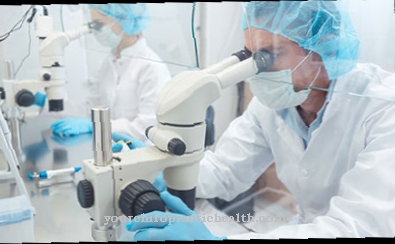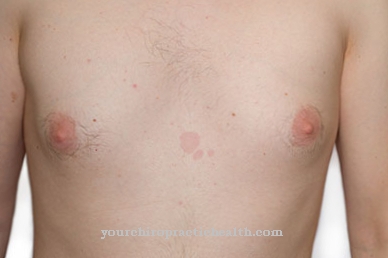People under a Prosopagnosia are unable to recognize a person they know personally by their face. In German usage this disease is also Facial blindness called.
What is Facial Blindness?
.jpg)
© fotokitas - stock.adobe.com
There are several different forms of Prosopagnosia: apperceptive, associative and congenital prosopagnosia. The congenital form is a congenital facial blindness.
Most people affected are not even aware of their condition because they consider this condition to be normal. They cannot understand that other people can perceive faces differently.
People with apperceptive prosopagnosia are unable to estimate the age of the person from a face.They cannot tell the gender of the person from the face either. In addition, it is difficult for them to infer the emotions of the person from the facial features.
People who suffer from associative prosopagnosia, on the other hand, can infer the age and gender of the person by looking at a face. A specific assignment, such as recognizing prominent people, is also not possible for them.
causes
The cause of the congenital Prosopagnosia, the congenital form of facial blindness, is not yet fully understood. Altered genetic information could be a possible trigger. For example, the mutation of a gene that is responsible for the function of the brain nerve cells.
In severe cases of facial blindness, it can also happen that a distinction between people and objects is not possible. Several areas of the brain are often damaged. The congenital form of facial blindness is an inherited disorder and is sometimes associated with autism or Asperger's syndrome.
The cause of apperceptive and associative prosopagnosia is damage to the brain. This can occur as a result of a disease such as a stroke or a traumatic injury. The degree of damage has an impact on the severity of facial blindness.
Symptoms, ailments & signs
The clinical picture of prosopagnosia determines the symptoms that are associated with this partial impairment. First of all, almost all those affected by facial blindness are able to recognize a face. The other information that can be obtained from the face varies. Some face-blind people can only remember faces for a very short time.
Apperceptive prosopagnostics cannot derive information such as age or gender from a face. Reading out emotions gives them great problems. A shown face of a known person is not linked to any other information about this person. Associative prosopagnostics can differentiate between faces, can assign gender and age, but cannot call up any further information.
Congenital prosopagnostics can experience their facial blindness in several ways. It ranges from the complete inability to recognize faces to poor attribution. Since this is innate, however, compensation strategies are usually created, which is why the restrictions are minor. If there are also problems with recognizing emotions, the behavior occasionally reminds of the symptoms of Asperger's.
Signs of some form of facial blindness include difficulty remembering faces and an inability to infer a person from a face. Even if people who are actually known are difficult to recognize in a changed context, this can be a sign.
Diagnosis & course
The innate Facial blindness it is not easy to diagnose in practice. The people affected usually automatically develop ways of recognizing people in their environment by other characteristics.
For example, a particular hairstyle, clothing, or voice and movements are assigned to a particular person. Often it is not noticed by outsiders that it was not the face of the person that was decisive for the recognition. If there are frequent mix-ups between people they know, this can be a sign of prosopagnosia.
Often those affected do not look their fellow human beings in the face because this seems completely uninteresting to them. A small child's lack of eye contact can also indicate other diseases such as autism and is not a sure sign of facial blindness.
In the case of the forms of facial blindness acquired through accident, injury or illness, the persons affected and the caregivers recognize that the perception and the ability to assign people to faces have changed.
Complications
Visual agnosia or prosopagnosia is a severe acquired or congenital symptomatology. Those affected have to reckon with complications in their lives for the rest of their lives. Social interaction is problematic with congenital facial blindness. Those affected do not recognize people they should know.
With acquired facial blindness, recognizing familiar people has become impossible. Those affected have to learn to assign their counterparts due to changed strategies, otherwise there is a risk of social isolation. The biggest problem is that those affected are not recognizable as blind to their fellow human beings. This leads to numerous misunderstandings and complications. In prosopagnosia, those affected cannot correctly assign objects, although they are often highly gifted.
In the most severe form of facial blindness, acquired apperceptive prosopagnosia, those affected cannot even correctly assign the age or gender of the other person. Frequently triggered by severe head injuries, strokes or brain tumors, additional complications can occur in the face-blind people. These are caused by the existing brain damage.
Depending on the severity of the prosopagnosia, the severity of the possible complications can also vary. In the most severe degree, those affected only recognize shadowy forms. For example, parking meters can be mistaken for faces due to their shape. Due to their size, they are kept for children or teenagers. Countless problems arise from this.
When should you go to the doctor?
If abnormalities in perception processing are noticed in everyday life, a review of the sensory impressions is necessary. In many cases, prosopagnosia goes unnoticed for a long time. The disease already exists at birth, so that the person affected is initially unaware of the visual impairments. People are often recognized as a matter of course through the voice, physique or clothing of the other person.
Therefore, the disease often requires the help and support of people in the immediate vicinity. If the person concerned cannot adequately describe the face of another person when prompted to do so, a doctor must be consulted.
Prosopagnosia is limited to a facial recognition disorder. Therefore all other visual sensations can be fully processed and recognized. This makes it difficult to discover the existing disorder in everyday life. In principle, children should be presented to a doctor for regular check-ups in their first few years of life. This is especially true if the disease has already occurred within the family.
Treatment & Therapy
There is no form of therapy through which a Facial blindness can fix. However, those affected can learn certain strategies in order to be able to reliably assign the people in their environment. A neuropsychologist can provide instructions on this.
In order to achieve optimal results, the skills have to be trained over and over again. Many other elements can be used to identify people. This can be, for example, the voice, the gait pattern, the stature or the posture of the person. Gestures can also be included.
Information about clothing, hairstyle or physical characteristics, such as scars, can also be helpful. Certain objects belonging to the person, such as the watch, jewelry or glasses, also facilitate recognition. Facial blind people who train these skills are often able to recognize certain people in the environment in which they usually encounter them. For example, you can tell your colleagues in the office apart.
However, if they meet these people in a different place, such as in a shopping center or in a restaurant, recognition takes significantly longer or is sometimes not even possible. People with the congenital form of prosopagnosia benefit when the disease is detected very early. Parents and other caregivers can then specifically encourage learning about alternative assignment options.
You can find your medication here
➔ Medicines to calm down and strengthen nervesprevention
There is no prevention in any of the three forms described Prosopagnosia possible. One can only try to minimize the known risk factors for strokes and other diseases through a healthy lifestyle. Many head injuries can be prevented by wearing crash helmets.
Aftercare
The extent of an existing prosopagnosia cannot be reduced by special follow-up care. The main goal now is for those affected to cope well with their everyday life with facial blindness and to lead a relatively normal life. In the case of congenital prosopagnosia, dealing with the restriction is much easier than if the disorder was caused by an accident or illness, for example.
The same can be observed with other disabilities such as blindness or deafness. Patients who were born with facial blindness have already adopted other strategies in their early childhood, with which they can differentiate between different people to a certain extent.
This also explains why many proso diagnosticians are often unaware that they are affected by this disorder. In such cases, therefore, follow-up care is usually not required and is usually not wanted by those affected. If prosopagnosia occurs later, however, alternative detection strategies have to be learned with great effort.
Targeted training may help here, but it is not part of standard aftercare. In some regions and on the Internet there are also self-help groups for those affected. Here the patients have the opportunity to exchange ideas with other prosopagnostics. Just knowing that you are not alone with the restriction can significantly improve the quality of life of those affected.
You can do that yourself
Prosopagnosia (facial blindness) cannot be cured. However, many sufferers develop strategies early on to compensate for the inability to recognize faces by developing other skills.
With a lot of training, proso diagnosticians can learn how to use other characteristics to recognize a suitable person. Such properties include voice, gait or gestures. The hairstyle, certain scars or birthmarks, certain glasses and other features often play a role. Sometimes a written or mental listing also helps to find out which people can be met in certain places with certain characteristics. If other features then match, the person can be identified. The development of these skills is absolutely necessary for those affected in order to find their way around the social environment. The training of these skills can be done under the guidance of a neuropsychologist.
To avoid exclusion, it sometimes helps to disclose the problems in the family or among trusted acquaintances. In this way, at least the accusation of being rude, rude or ignorant can be refuted. There are also self-help groups for prosopagnostics, in which experiences in dealing with the environment can be exchanged. In addition, interesting strategies for recognition are exchanged here. You can search for these self-help groups and make contacts on the internet, among other places.



.jpg)






















